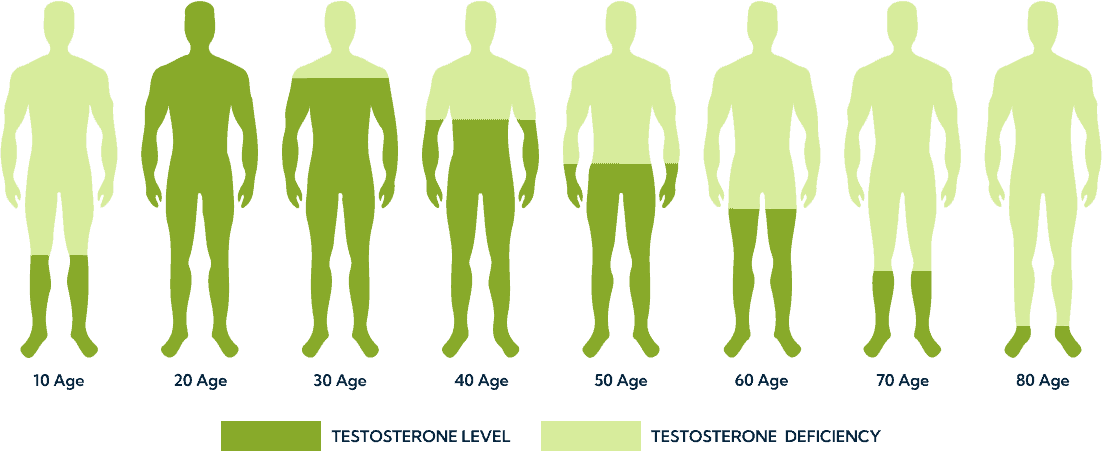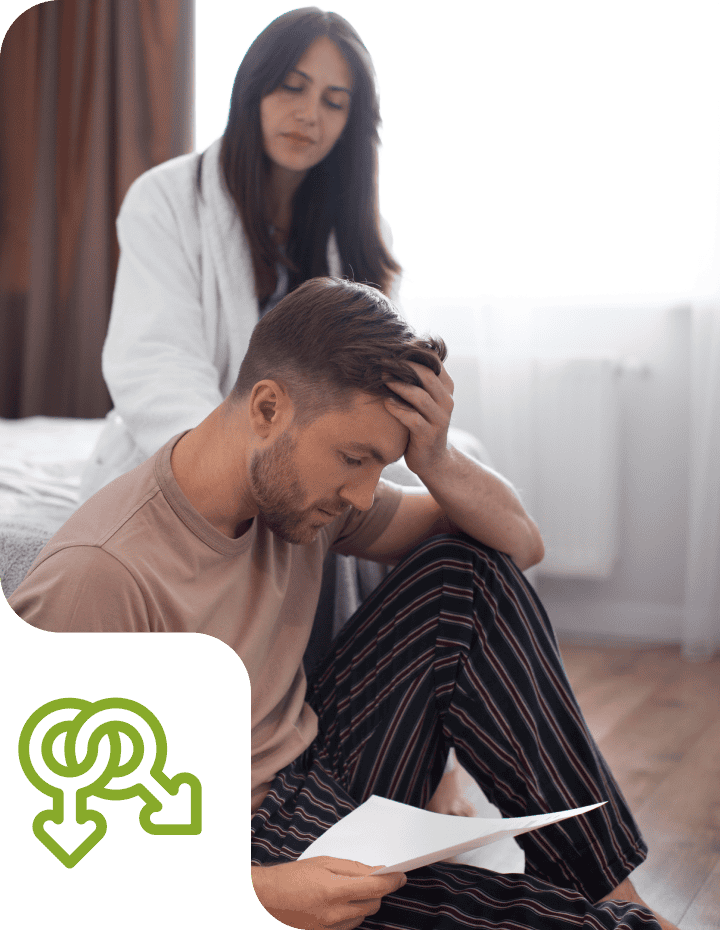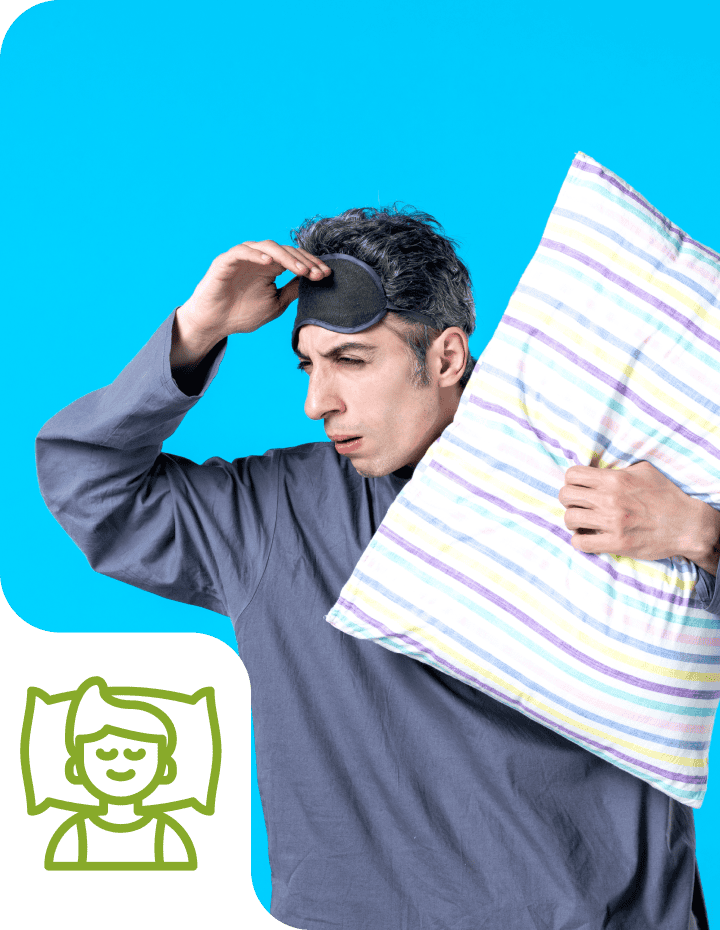
TRT - Testosterone Replacement Therapy
Aging is inevitable, and for many, it signals the beginning of a new chapter - one where you cross off bucket list items and live life to the fullest, on your own terms. However, for some men, aging is a horrible prospect, filled with chronic fatigue, irritability, and inability to perform in the bedroom. If you're concerned about life in middle age and beyond, we've got great news: there are easy, proven steps that you can take to help stop the negative effect of aging.
Global Life Rejuvenation was founded to give men a new lease on life - one that includes less body fat, fewer mood swings, and more energy as you age. If you're ready to look and feel younger, it's time to consider TRT (testosterone replacement therapy), and growth hormone peptides. These therapies for men are effective, safe, and customized to fit your goals, so you can keep loving life as you get older.
TRT, and growth hormone peptide therapies bridge the gap between your old life and the more vibrant, happier version of you. With a simple click or call, you can be well on your way to a brighter future. After all, you deserve to be the one in charge of your wellness and health. Now, you have the tools to do so - backed by science and applied by our team of TRT and HRT experts with more than 13 years of experience.

- Unlock A More Youthful You With Testosterone Replacement Therapy In Bergenfield, NJ
- TRT and Anti-Aging Medicine for Men
- Common Symptoms of Low Testosterone
- Benefits of TRT and Anti-Aging Medicine for Men
- Fight Back Against Male Menopause
- Reverse Aging with Growth Hormone Peptides in Bergenfield, NJ
- Your New, Youthful Lease on Life Starts Here
 Have A Question?866-797-1140
Have A Question?866-797-1140
Testosteronal Hormone Level

TRT and Anti-Aging Medicine for Men in Manhattan, NY
For men, getting older comes with its perks, like living life on their own terms and not having to "sweat the small stuff" day in and day out. At the same time, there are aspects of aging that men dread, like hormonal changes. Yes, you read that right - men, not just women, go through hormonal changes as they age. For men, the biggest change involves a drop in testosterone.
Lower levels of testosterone can wreak havoc on a male's mind and body and when left untreated, can result in symptoms like:
- Erectile Dysfunction
- Depression
- Irritability
- Low Sex Drive
- Hair Loss
- Less Muscle Mass
- Problems Concentrating
Those symptoms are concerning, but with testosterone replacement therapy and anti-aging medicine, many males improve their quality of life with age. The good news is that TRT and anti-aging meds aren't only reserved for "old guys." In fact, there's no magic age at which men should start thinking about hormone replacement therapy. Everyone's body is different, so if you're experiencing the above conditions in your mid-30s, TRT could be a viable solution when you consult with a doctor.

Testosterone is a crucial hormone for men and plays an important role throughout the male lifespan. Most of a male's testosterone is produced through the testicles. Also called the male sex hormone, testosterone starts playing its part during puberty.
When a male goes through puberty, testosterone helps males develop:
- Facial Hair
- Body Hair
- Deeper Voice
- Muscle Strength
- Increased Libido
- Muscle Density
As boys turn to men and men grow older, testosterone levels deplete naturally. Sometimes, events like injuries and chronic health conditions like diabetes can lower testosterone levels. Unfortunately, when a man loses too much T, it results in hypogonadism. When this happens, the testosterone must be replaced, or the male will suffer from symptoms like muscle loss, low libido, and even depression.

TRT is exactly what it sounds like: a treatment option for men that replaces testosterone so that your body regulates hormones properly and restores balance to your life. Also called androgen replacement therapy, TRT alleviates the symptoms that men experience with low T.
Originally lab-synthesized in 1935, testosterone has grown in popularity since it was produced. Today, TRT and other testosterone treatments are among the most popular prescriptions in the U.S.
Without getting too deep into the science, TRT works by giving your body the essential testosterone it needs to function correctly. As the primary androgen for both males and females, testosterone impacts many of the body's natural processes - especially those needed for overall health. For example, men with low T are more prone to serious problems like cardiovascular disease and even type-2 diabetes.
When your body quits making enough testosterone, it causes your health to suffer until a solution is presented. That's where TRT and anti-aging medicine for men can help. TRT helps balance your hormones and replenish your depleted testosterone. With time, your body will begin to heal, and many symptoms like low libido and irritability begin to diminish.

For men, aging is the biggest contributor to lower testosterone levels, though there are other causes like obesity, drug abuse, testicular injuries, and certain prescribed medications. Sometimes, long-term health conditions like AIDS, cirrhosis of the liver, and kidney disease can lower testosterone levels.
When a man's testosterone levels drop significantly, it alters his body's ratio of estrogen and testosterone. Lower testosterone levels cause more abdominal fat, which in turn results in increased aromatase, which converts even more testosterone into estrogen.
If you're concerned that you might have low T, you're not alone. Millions of men in the U.S. feel the same way. The best way to find out if your testosterone is low is to get your levels tested.
For sustainable testosterone replacement therapy benefits, you must consult with hormone doctors and experts like those you can find at Global Life Rejuvenation. That way, you can find the root cause of your hormone problems, and our team can craft a personalized HRT plan tailored to your needs.
Common Symptoms of Low Testosterone
Are you used to blasting through a productive day and accomplishing all your daily goals? Do you find yourself losing muscle mass and the craving to be intimate with your partner? Does your partner complain about how irritable you have become? If you're not usually a curmudgeon, your body could be giving you a sign. It could be time to speak with a doctor about TRT and anti-aging medicine for men in Bergenfield, NJ.
If you're experiencing any of the following symptoms, you might be battling against low testosterone:
One of the most common reasons that men choose TRT is because they have lost that "spark" with their partner. It's not easy for a man to hear that they're not performing like they used to.
Intimacy is a powerful part of any relationship. When a once-healthy sex life dwindles, it can cause serious relationship issues.
The good news is that low libido doesn't have to be a permanent problem. TRT and anti-aging medicines help revert hormone levels back into their normal range. When this happens, many men have a more enjoyable life full of intimacy and sex drive.

Weak erections - it's an uncomfortable subject for many men in the U.S. to talk about. It's even worse to experience first-hand. You're in the midst of an intimate moment, and you can't do your part. Despite being perfectly normal, many men put blame and shame upon themselves when they can't achieve an erection. And while the inability to perform sexually can be caused by poor diet, obesity, and chronic health conditions, low testosterone is often a contributing factor.
Fortunately, weak erections are a treatable condition. The best way to regain your confidence and ability in bed is to speak with your doctor. Once any underlying conditions are discovered, options like TRT may be the best course of treatment.

Do you find it harder and harder to work out and lift weights in the gym? Are you having problems lifting heavy items that you once had no problem lifting?
Recent studies show that when men are inactive, they lose .5% of muscle strength every year, from ages 25 to 60. After 60, muscle loss doubles every decade. While some muscle loss is common as men age, a significant portion can be tied to low testosterone levels. When a man's T levels drop, so does his muscle mass.
Testosterone is a much-needed component used in gaining and retaining muscle mass. That's why many doctors prescribe TRT Manhattan, NY, for men having problems with strength. One recent study found that men who increased their testosterone levels using TRT gained as much as 2.5 pounds of muscle mass.
Whether your gym performance is lacking, or you can't lift heavy items like you used to, don't blame it all on age. You could be suffering from hypogonadism.

If you're like millions of other men in their late 20s and 30s, dealing with hair loss is a reality you don't want to face. Closely related to testosterone decline and hormone imbalances, hair loss is distressing for many men. This common symptom is often related to a derivative of testosterone called DHT. Excess amounts of DHT cause hair follicles to halt their production, causing follicles to die.
Because hair located at the front and crown is more sensitive to DHT, it grows slower than other follicles and eventually stops growing permanently. Thankfully, TRT and anti-aging treatments for men in Manhattan, NY, is now available to address hair loss for good.
While it's true that you can't change your genes, you can change the effects of low testosterone on your body. Whether you're suffering from thinning hair or hair loss across your entire head, TRT and other hormone therapies can stop hair loss and even reverse the process.

Also called "man boobs," gynecomastia is essentially the enlargement of male breast tissue. This increase in fatty tissue is often caused by hormonal imbalances and an increase in estrogen. For men, estrogen levels are elevated during andropause. Also called male menopause, andropause usually happens because of a lack of testosterone.
If you're a man between the ages of 40 and 55, and you're embarrassed by having large breasts, don't lose hope. TRT is a safe, effective way to eliminate the underlying cause of gynecomastia without invasive surgery. With a custom HRT and fitness program, you can bring your testosterone and estrogen levels back to normal before you know it.

Decreased energy was once considered a normal part of aging. Today, many doctors know better. Advances in technology and our understanding of testosterone show that low T and lack of energy often go hand-in-hand.
If you're struggling to enjoy activities like playing with your kids or hiking in a park due to lack of energy, it could be a sign of low T. Of course, getting tired is perfectly normal for any man. But if you're suffering from continual fatigue, a lack of enjoyment, or a decrease in energy, it might be time to speak with a doctor.
Whether you're having a tough time getting through your day or can't finish activities you used to love, TRT could help.

A study from 2011 showed that men who lose a week's worth of sleep can experience lowered testosterone levels - as much as 15%, according to experts. Additional research into the topic found almost 15% of workers only get five hours of sleep (or less) per night. These findings suggest that sleep loss negatively impacts T levels and wellbeing.
The bottom line is that men who have trouble sleeping often suffer from lower testosterone levels as a result. If you find yourself exhausted at the end of the day but toss and turn all night long, you might have low T.
TRT and anti-aging medicines can restore your T levels back to normal, which can help you sleep better with proper diet and exercise.

You're feeling down about everything, and there's no solid explanation for why you're in such a crummy mood. Your daily life is great and full of success, but you can't help but feel unexcited and unmotivated. If you're experiencing symptoms like these, you may be depressed - and it may stem from low testosterone.
A research study from Munich found that men with depression also commonly had low testosterone levels. This same study also found that depressed men had cortisol levels that were 67% higher than other men. Because higher cortisol levels lead to lower levels of testosterone, the chances of severe depression increase.
Depression is a very real disorder and should always be diagnosed and treated by your doctor. One treatment option gaining in popularity is TRT for depression. Studies show that when TRT is used to restore hormone levels, men enjoy a lighter, more improved mood. That's great news for men who are depressed and have not had success with other treatments like anti-depression medicines, which alter the brain's chemistry.

Ask anyone over the age of 50 how their memory is, and they'll tell you it wasn't what it used to be. Memory loss and lack of concentration occur naturally as we age - these aren't always signs of dementia or Alzheimer's.
However, what many men consider a symptom of age may be caused by low testosterone. A 2006 study found that males with low T levels performed poorly on cognitive skill tests. These results suggest that low testosterone may play a part in reducing cognitive ability. If you're having trouble staying on task or remembering what your schedule is for the day, it might not be due to your age. It might be because your testosterone levels are too low. If you're having trouble concentrating or remembering daily tasks, it could be time to talk to your doctor.
Why? The aforementioned study found that participating men experienced improved cognitive skills when using TRT.

Even though today's society is more inclusive of large people, few adults enjoy gaining weight as they age. Despite their best efforts, many men just can't shed the extra pounds around their midsections, increasing their risk of heart disease and cancer.
Often, male weight gain is caused by hormone imbalances that slow the metabolism and cause weight to pile on. This phase of life is called andropause and happens when there is a lack of testosterone in the body. Couple that with high cortisol levels, and you've got a recipe for flabby guts and double chins.
Fortunately, TRT treatments and physician-led weight loss programs can correct hormone imbalances and lead to healthy weight loss for men.












Benefits of TRT and Anti-Aging Medicine for Men in Englewood, NJ
The benefits of hormone replacement therapy for men are numerous. TRT not only grants relief from low-T symptoms but can help give protection against age-related diseases. Additionally, doctors now recognize male testosterone as an important role in alleviating depression.
Some of the most exciting benefits of TRT can include:
- Reduction in Body Fat
- Increased Strength
- More Muscle Mass
- More Energy
- Lower Risk of Erectile Dysfunction
- Higher Sperm Production
- Healthy Reproductive Tissues
- Lower Risk of Heart Disease and Diabetes
- Lower Risk of Anxiety
- Lower Risk of Depression
Fight Back Against Male Menopause
Because men do not go through a specific period of hormonal changes like women do (called menopause), many doctors refer to "male menopause" as androgen decline. This is just another term for low testosterone, but like female menopause, the symptoms can be serious and affect your quality of life.
The best way to fight back against male menopause is with male HRT treatment from Global Life Rejuvenation. We provide the following HRT treatments for men:
- Testosterone Replacement Therapy (TRT)
- Sermorelin (Sermorelin Acetate)
- Human Growth Hormone (HGH)
Our treatment options are personalized for your body and are available as creams, gels, injectables, and implantable pellets. To find out if testosterone replacement therapy is safe for you, contact Global Life Rejuvenation today to schedule your comprehensive testing and anti-aging treatment consultation.

Reverse Aging with Growth Hormone Peptides in Manhattan, NY
Growth hormone peptides are an innovative therapy that boosts the natural human growth hormone production in a person's body. These exciting treatment options help slow down the aging process and give you a chance at restoring your youth.

Sermorelin is a synthetic hormone peptide, like GHRH, which triggers the release of growth hormones. When used under the care of a qualified physician, Sermorelin can help you lose weight, increase your energy levels, and help you feel much younger.

Sermorelin is a synthetic hormone peptide, like GHRH, which triggers the release of growth hormones. When used under the care of a qualified physician, Sermorelin can help you lose weight, increase your energy levels, and help you feel much younger.
Benefits of Sermorelin include:
- Better Immune Function
- Improved Physical Performance
- More Growth Hormone Production
- Less Body Fat
- Build More Lean Muscle
- Better Sleep
Your New, Youthful Lease on Life Starts Here
Whether you are considering our TRT services, HRT for women, or our growth hormone peptide services, we are here to help. The first step to turning back the hand of time starts by contacting Global Life Rejuvenation.
Our friendly, knowledgeable TRT and HRT experts can help answer your questions and walk you through our procedures. From there, we'll figure out which treatments are right for you. Before you know it, you'll be well on your way to looking and feeling better than you have in years!
Request a Consultation

Latest News in Manhattan, NY
New Jersey mayor proposes reverse congestion pricing after new NYC toll: ‘Same opportunity to push the buttons’
Fox Newshttps://nypost.com/2025/01/13/us-news/new-jersey-mayor-proposes-reverse-congestion-pricing-after-new-nyc-toll/
A New Jersey mayor is proposing the idea of a reverse congestion pricing toll after New York City implemented its controversial levy last week.Jersey City Mayor Steven Fulop, who is also running for governor of the Garden State, floated the idea, according to Fox 5 New York.“New Jersey has the same opportunity to push the buttons that New York is pushing against us,” Fulop told the outlet. &...
A New Jersey mayor is proposing the idea of a reverse congestion pricing toll after New York City implemented its controversial levy last week.
Jersey City Mayor Steven Fulop, who is also running for governor of the Garden State, floated the idea, according to Fox 5 New York.
“New Jersey has the same opportunity to push the buttons that New York is pushing against us,” Fulop told the outlet. “We could do that to them, but the goal is to get to a table to have a reasonable solution.”
The mayor said he believes reverse congestion pricing is the appropriate response to New York City’s new toll, which imposes fees on vehicles that enter busy parts of Manhattan as a way to encourage people to take the subway.
“There’s plenty of crossings between Staten Island, New York, Bergen County, Hudson County into New Jersey,” Fulop said. “There’s plenty of opportunities to have the same sort of impact fee that New York is putting on New Jersey.”
Fulop said he believes the money made from reverse congestion pricing should fund New Jersey’s mass transit system, which has suffered from delays and cancellations.
“My view is that New Jersey Transit is a terrible product, and it should be invested in more, and until you get a reliable transportation system in New Jersey, you can’t responsibly think that people are going to take the trains,” Fulop said. “But this was an opportunity to get hundreds of millions of dollars into New Jersey Transit, and I think the governor just took a very easy political approach.”
There was initially the possibility for New Jersey to receive hundreds of millions of dollars from New York City’s new toll, but that fell through amid litigation.
The details of Fulop’s proposal are not yet finalized, but he said gantries or toll sites could be stationed outside tunnels and bridges in New Jersey.
He said that, similar to congestion pricing, there may be exemptions or crossing credits.
It is unclear if New Jersey residents would be required to pay the toll to re-enter their home state like some New Yorkers do for congestion pricing.
Congestion toll cuts time on tunnel crossings, but few effects on NYC traffic
Nikita Biryukovhttps://newjerseymonitor.com/2025/01/13/congestion-toll-cuts-time-on-tunnel-crossings-but-few-effects-on-nyc-traffic/
As the second workweek of congestion pricing begins, supporters of the new tolling program point to speedier commute times as proof the program is working as intended.Commute times at two tunnels taking New Jersey drivers into New York City fell in congestion pricing’s first week, but traffic in the city remained largely static, according to a traffic tracker run by two college students.With few exceptions, crossings through the Holl...
As the second workweek of congestion pricing begins, supporters of the new tolling program point to speedier commute times as proof the program is working as intended.
Commute times at two tunnels taking New Jersey drivers into New York City fell in congestion pricing’s first week, but traffic in the city remained largely static, according to a traffic tracker run by two college students.
With few exceptions, crossings through the Holland and Lincoln tunnels were faster in the first week of congestion pricing, which imposed $9 in additional tolls on car drivers entering Manhattan’s central business district, than before its implementation. Sometimes, crossings through the two tunnels were twice as fast.
“We’re having consistent reports that a.m. peak travel into the CBD is much faster. I think you’ve all heard it,” Metropolitan Transportation Authority CEO Janno Lieber said at a press conference Friday.
Drivers of passenger vehicles who use the two tunnels to enter the congestion pricing zone — that’s below 60th Street — during peak hours can receive a $3 toll credit.
Supporters of congestion pricing have said the policy is meant to reduce gridlock and pollution in Manhattan.
But the tracker, developed by Brown University senior Benjamin Moshes and Northeastern University freshman Joshua Moshes (who are brothers), showed virtually no change in traffic inside the tolling zone.
It isn’t immediately clear how congestion pricing affected traffic at other crossings into New York City.
Some opponents of the policy have warned it will push motorists to less-tolled crossings not subject to congestion pricing, like the George Washington Bridge.
Though the tracker does not measure commute times over the George Washington Bridge, it identified longer commutes on some other alternate routes.
“Traffic seems to have increased … on ‘spillover routes’ such as the Hugh L. Carey Tunnel and FDR Drive. These routes are near the congestion zone but are not being charged,” said Benjamin Moshes. “Traffic may have shifted to these from the above routes with decreased travel times.”
Those increases appeared smaller than the drop in traffic on affected crossings, Moshes said.
A spokesperson for the Port Authority of New York and New Jersey, which manages the George Washington Bridge and other Hudson River crossings, said the agency would not have relevant traffic volume data until February.
Lawmakers in New Jersey have railed against congestion pricing, arguing New York was seeking to tax New Jersey residents to fill a $15 billion hole in the Metropolitan Transportation Authority’s capital budget while shifting Big Apple pollution to the Garden State.
Gov. Phil Murphy has challenged congestion pricing in court with claims that federal authorities failed to properly weigh its impact on air quality in New Jersey. His spokespeople did not respond to a request for comment.
Though New York Gov. Kathy Hochul in June suspended an earlier proposal that would have immediately set congestion tolls to $15, tolls will reach that level in 2031 after rising to $12 per crossing in 2028.
[subscribe width=”full” align=”right” message=””/
Our stories may be republished online or in print under Creative Commons license CC BY-NC-ND 4.0. We ask that you edit only for style or to shorten, provide proper attribution and link to our website. AP and Getty images may not be republished. Please see our republishing guidelines for use of any other photos and graphics.
Bus times to NY improve, traffic at tunnels drops as congestion pricing kicks in
Colleen Wilsonhttps://www.northjersey.com/story/news/transportation/2025/01/10/congestion-pricing-nyc-bus-times-manhattan-improve-nj/77574192007/
3-minute readAmanda WallaceNorthJersey.com0:001:32Here's how one Cranford-based business owner described the impact of Manhattan's new congestion pricing toll program so far: It's like "running buses in Wichita."Joe Colangelo, founder and CEO of the private commuter bus company Boxcar, said the commute times for all six bus routes from Morris, Essex, Uni...
3-minute read
NorthJersey.com
Here's how one Cranford-based business owner described the impact of Manhattan's new congestion pricing toll program so far: It's like "running buses in Wichita."
Joe Colangelo, founder and CEO of the private commuter bus company Boxcar, said the commute times for all six bus routes from Morris, Essex, Union and Bergen counties into midtown Manhattan have significantly improved this week since the congestion pricing toll went into effect.
Plus, the buses have fully booked up since the new tolling program to enter the city center went live early last Sunday morning.
Boxcar buses normally make five stops across Manhattan before going through the Lincoln Tunnel during the afternoon commute, which used to take about 30 minutes. In the first few days of the week, Colangelo said, it took 12 to 14 minutes.
Story continues below photo gallery.
"This is going to lead to us adding buses very quickly and expanding to other areas much more quickly than we would have otherwise," Colangelo said. "We did more rides yesterday than we did when the trains were down for three straight days" last summer.
On the other hand, congestion pricing hasn't improved the commute for Monique Baptiste, who drives to Harlem from Clinton Hill in Newark.
She said traffic at the George Washington Bridge used to snarl around 7:30 a.m., but this week it seemed to start piling up around 6 a.m. The George Washington Bridge was not subject to the congestion pricing toll, and some suspected that drivers might reroute — or "toll shop" — by using the bridge to cross the Hudson River.
That was among the concerns highlighted in New Jersey's lawsuit that twice failed in court to stop congestion pricing in the days leading up to its start.
After the experience driving over the bridge, Baptiste switched to the PATH train and said the Exchange Place stop in Jersey City was busier than usual. Cecilia Gomes, another Exchange Place regular, called it "insane" this week.
"The moral of the story is the NJ-NY commute just got a whole lot less reasonable in 2025," Baptiste said.
An array of experiences based on mode of commute
Dell Green, from the Bedminster area, decided to make the switch from car to train to avoid the congestion pricing toll.
"I don't regularly [commute] anymore but I used to drive in, so now I'm not. I'm not paying the $9 to go into Midtown," he said while waiting at NJ Transit's Morristown stop.
Marnie Briskin, who moved to the Morristown area a year and a half ago, said she hasn't noticed a big change during her train commute this week.
"People would say that you can never find parking at the Morristown train station, and I have never had trouble finding parking," she said.
Kevin Hanse uses a variety of NJ Transit buses — the 163/164, 171, 144, 320 — depending on where he's going in New York, and said he's noticed a substantial difference.
"More people are definitely riding the buses, and they're fast through the helix — especially once past the [Jersey City] car traffic," Hanse said. "Buses are beating the timetable, since that was calculated with the old traffic factored in."
First congestion toll of its kind in the US
Manhnattan's is the first tolling program of its kind to launch in the U.S. It's modeled after similar programs in London, Stockholm and Singapore.
The overarching goals are to reduce traffic, improve commutes for drivers, cut down on pollution and, in New York's case, fund capital projects for the Metropolitan Transportation Authority, according to the 2019 state law that mandated its creation.
The $9 peak hour toll for passenger vehicles is charged to those entering Manhattan below 60th Street, including vehicles entering from New Jersey by way of the Lincoln and Holland tunnels.
Colangelo, of Boxcar, is cautiously optimistic about whether the new traffic patterns will hold. He notes that several factors could have affected commutes this week outside of the new toll, including the snowy conditions Monday and return-to-office mandates that coincided with the start of the new year.
Congestion pricing tracker launched by college students
Colangelo and commuters will be keeping a close eye on a congestion pricing tracker that was launched Sunday by two undergraduates, brothers Joshua and Benjamin Moshes, who attend Northeastern University and Brown University, respectively.
The brothers gathered traffic data before and after congestion pricing started, to compare traffic along 19 routes into the Manhattan toll zone, which is 60th Street and below unless drivers stay on perimeter highways, such as the FDR Drive and the West Side Highway.
Some routes, including those using the FDR Drive, jumped in commute times, while others plummeted, such as those using the Brooklyn Bridge, which had been a free crossing to enter Manhattan until congestion pricing. Traffic using the Lincoln and Holland tunnels also dropped.
The goal of the tracker, Joshua Moshes said, was to "make a website with unbiased data so people can make their own decisions" after congestion pricing kicked in.
"We want people to know that good data can lead to better decisions, and we want people to make better-informed decisions based on the tracker," said Benjamin Moshes. "We also know that people from other cities are also following along with this, and we want them to also get some insight."
Here’s how N.J. drivers will get a E-ZPass toll credit for Lower Manhattan congestion fee
Larry Higgshttps://www.nj.com/news/2025/01/heres-how-nj-drivers-will-get-a-e-zpass-toll-credit-for-lower-manhattan-congestion-fee.html
Three days into New York’s congestion pricing program that charges $9 to enter Lower Manhattan and some drivers said they haven’t seen the $3 toll credit when they checked their E-ZPass statements.The confusion is among New Jersey drivers who’ve contacted NJ Advance Media to say they haven’t received toll credit or seen it on their E-ZPa...
Three days into New York’s congestion pricing program that charges $9 to enter Lower Manhattan and some drivers said they haven’t seen the $3 toll credit when they checked their E-ZPass statements.
The confusion is among New Jersey drivers who’ve contacted NJ Advance Media to say they haven’t received toll credit or seen it on their E-ZPass statement.
Some questioned if the toll credit is offered only to drivers with a New York issued E-ZPass.
We asked the MTA and spokesperson Aaron Donovan explained it takes time for the toll credits to show up on drivers E-ZPass statements.
“Any driver with any E-ZPass from any state receives a credit for using any of the four tunnels,” he said. “There is a lag time before the tunnel credits are posted to E-ZPass accounts.”
That lag time is explained in the congestion pricing Frequently Asked Questions page under the E-ZPass heading “How soon will the toll appear on my E-ZPass account?”
For E-ZPass customers outside New York, the congestion toll will post in 4 to 6 days, and crossing credits will post two to four days after that.
New York E-ZPass customers see the toll post in three days and crossing credits post one day after that. Tolls by Mail customers will see the charges when the invoice is sent.
The issue was also covered in the MTA’s our Congestion Relief Zone newsletter that went out to subscribers last week.
The Triborough Bridge and Tunnel Authority is running congestion pricing for the Metropolitan Transportation Authority, which the triborough authority is a part of.
It’s toll rate schedule says non-commercial passenger vehicles entering through the Holland and Lincoln tunnels and paying with E-ZPass will receive a $3 toll credit off the $9 congestion fee.
The MTA also has a congestion pricing toll rate calculator on its website. It asks for the type of vehicle, time you’re entering the city, which tunnel you’re using and which tunnel you plan to leave by. It only asks if you’re paying with an E-ZPass and doesn’t ask where it was issued.
For non-commercial passenger vehicles it show the $3 credit applied for the Holland and Lincoln tunnels for a total of $6.
The MTA has a discount program for two groups of people, low income and people who need to travel to a medical facility in the congestion zone. Those are different than the toll credit.
Drivers have to apply for those discounts and they require a New York issued E-ZPass. The toll credits do not have that requirement.
Congestion pricing, which was made a New York state law in 2019, was created to help reduce traffic, crashes and air pollution in Manhattan and raise $1 billion annually for subway, bus and commuter rail projects by charging a fee for drivers to enter Manhattan’s central business district south of 60th Street.
It is the first such program in the nation. London and Stockholm have similar programs. A projected 80,000 to 110,000 commuters are forecasted to switch from driving to transit to avoid the fee, MTA officials said.
Our journalism needs your support. Please subscribe today to NJ.com.
Larry Higgs may be reached at [email protected]. Follow him on X @CommutingLarry
New Jersey mayor proposes 'reverse congestion pricing' toll
Michael Stallonehttps://www.fox5ny.com/news/nyc-congestion-pricing-tracker-nj-reverse-new-jersey
The BriefCould New Jersey have the last laugh?The gantries are up in Manhattan for the controversial congestion pricing toll, but Jersey City Mayor Steven Fulop, who's also running for NJ governor, is floating the idea of a reverse congestion pricing toll.What they're saying:"New Jersey has the same opportunity to push the buttons that New York is pushing again...
The Brief
Could New Jersey have the last laugh?
The gantries are up in Manhattan for the controversial congestion pricing toll, but Jersey City Mayor Steven Fulop, who's also running for NJ governor, is floating the idea of a reverse congestion pricing toll.
What they're saying:
"New Jersey has the same opportunity to push the buttons that New York is pushing against us," Fulop said. "We could do that to them, but the goal is to get to a table to have a reasonable solution."
NJ mayor talks 'reverse congestion pricing' toll
Jersey City Mayor Steven Fulop, who's also running for NJ governor, is floating the idea of a reverse congestion pricing toll. He joined Good Day New York to explain.
Fulop believes reverse congestion pricing is the answer to New York City's new toll.
"There's plenty of crossings between Staten Island, New York, Bergen County, Hudson County into New Jersey," Fulop said. "There's plenty of opportunities to have the same sort of impact fee that New York is putting on New Jersey."
Big picture view:
The idea is the money will go to fund New Jersey’s mass transit system, plagued by delays and cancelations.
Featured
The landmark initiative, which began on Sunday, is designed to reduce traffic congestion, improve air quality and raise funds for much-needed public transit upgrades.
"My view is that New Jersey Transit is a terrible product, and it should be invested in more, and until you get a reliable transportation system in New Jersey, you can't responsibly think that people are going to take the trains," Fulop said. "But this was an opportunity to get hundreds of millions of dollars into New Jersey Transit, and I think the governor just took a very easy political approach."
There was an option for New Jersey to get hundreds of millions from New York's new toll, but that opportunity was lost in the midst of litigation.
What we don't know:
The details have yet to be flushed out, but Fulop says gantries or toll sites could be stationed outside of tunnels and bridges in New Jersey. Like congestion pricing, there may be exemptions or crossing credits.
Featured
The crackdown could include a $50 fine for parked cars with obstructed plates, in addition to penalties for those caught driving through toll areas undetected.
It’s unclear if, like congestion pricing, New Jerseyans would pay the toll to reenter their home state like some New Yorkers do.
The other side:
reached out to the MTA and transit advocacy groups to gauge their interest, but they declined to comment. We also reached out to New Jersey Gov. Phil Murphy to get his take, but haven't heard back.
Disclaimer:

Service Areas

 WITH OVER 13 YEARS OF EXPERIENCE
WITH OVER 13 YEARS OF EXPERIENCE
